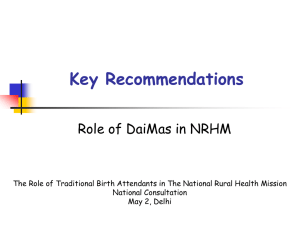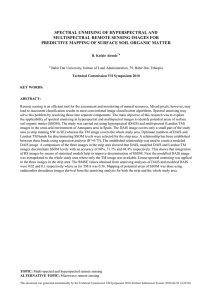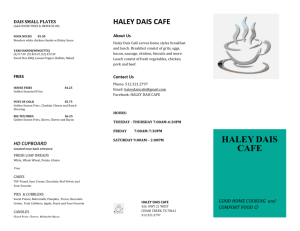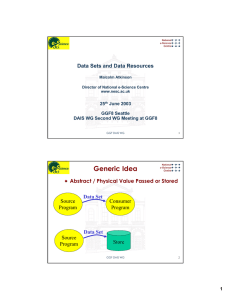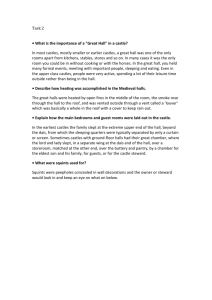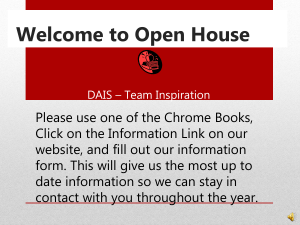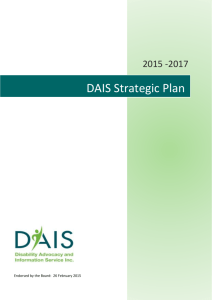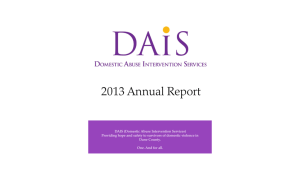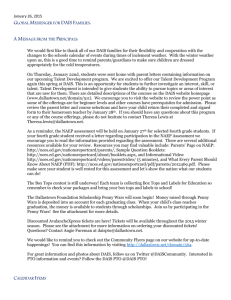Global HRM
advertisement
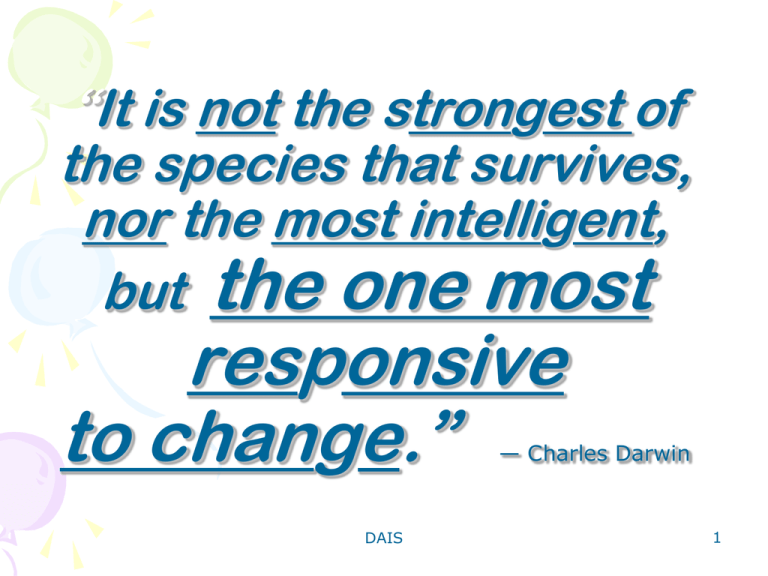
“It is not the strongest of the species that survives, nor the most intelligent, but the one most responsive to change.” — Charles Darwin DAIS 1 Role of HRM Organizational structure DAIS 2 DAIS 3 7S - Richard Pascale, Tony Athos, Tom Peters and Bob Waterman The Principles of the model are: • All the elements are equally important. • All elements are inter-connected- altering one element affects other elements. • Effective strategy is more than individual subjects - it is the relationship between strategy, structure and systems coupled with skill, style and super ordinate goals. • Provide a checklist of important variables for evaluating the proposed strategies (coherence) • It provides a way of examining an organisations operation and its inter-relationships and core competencies. • Peters and Waterman's in Search of Excellence 1982, uses it as a starting point for identifying and examining other relationships. DAIS 4 Organizational architecture Totality of a firm’s organization : formal structure, control systems, incentives, processes, organizational culture and people. To be effective: – Strategy and structure must fit – Strategy, structure and competitive environment must fit DAIS 5 Organizing human resources • You can’t see it, but it’s probably the most important thing in a business. • Why do organisations need a structure? DAIS 6 Let’s address these questions: 1. What is meant by organisation structure? 2. How does one design a suitable structure? DAIS 7 Design of structure Nature of function, type of business, geographical area – Entrepreneur /small team – Functional structure – Product structure – Key customers structure (verticals) DAIS 8 Key principles of org struc 1. Span of control: wide/ narrow – Number of subordinates reporting directly to a manager – Wider the span of control; the greater the degree of delegation – More trust : everyone made accountable 2. Levels of hierarchy : tall – Slow decision making – Narrow span of control – Greater sense of remoteness at lower levels – Greater the levels of hierarchy, longer the chain of command 3. Chain of command : route through which authority is passed on DAIS 9 Key principles of org struc (contd) 4.Delegation : passing down of authority to perform tasks and take decisions from higher to lower levels – Accountability – Authority – Responsibility DAIS 10 Centralisation/ Decentralisation Centralisation Keeping important decision-making powers in the HO Decentralisation Passing decision making powers to managers in other areas DAIS 11 Centralisation Decentralisation Fixed set of rules and procedures Allows more local decisions to be made which reflect different conditions Business has consistent policies, prevents conflict Develops more junior managers and prepares them for challenging roles Senior managers take Allows delegation and decisions in the interest of the empowerment and these will whole business have positive effects on motivation Central buying should allow Decision making in response for greater economies of scale to changes – local market conditions should be quicker and more flexible Senior managers at central office will be experienced decision makers HO involvement not required all the time 12 DAIS Centralization + facilitates coordination + ensures that decisions are consistent with organizational objectives + gives top-level managers means to bring about needed organizational changes + can avoid duplication of activities DAIS 13 Why Decentralization? + overburdening of top management if decisionmaking is centralised + gives top-management time to focus on critical issues by delegating more routine issues to lower-level managers + motivational theories favour individual freedom and empowerment + better decisions made closer to the spot + increasing control – fewer excuses for poor performance if power given to (subunits) managers DAIS 14 Do all organisations need structure? Draw one for your dream company • • Formal division of organization to subunits (products, functions) Location of decision-making responsibilities within that structure When done, evaluate it in terms of: 1. 2. 3. 4. 5. Speed, accuracy of communication Span of control Centralization Degree of delegation used Can structure affect employee motivation, performance DAIS 15 Does your org-chart show? Who has overall responsibility for decision making? Formal relationships between different people and departments Ways in which accountability and authority may be passed down the organisation = chain of command The number of subordinates reporting to each senior manager = span of control Formal channels of communication – vertical, horizontal Identity of the supervisor or manager to whom each employee is answerable and should report to DAIS 16 Points to ponder… Tall v Flat: “Tall” organizations have layers of managers structured in a hierarchy. ‘Flatter’ companies have fewer layers - which they claim gives them more flexibility. Chain of Command: A tall company has a long chain of command, but managers have a narrow span of control. Hierarchies have their advantages, but are they too rigid? Team Working: In multinational drugs company Eli Lily, staff work in numbers of different teams in a matrix structure. Human Costs: Firms flatten hierarchies by cutting staff, but what about the human cost? DAIS 17 size, range of activities influence org-structure? • Small firms entrepreneurial Owner DAIS 18 Does style of mgmt, retrenchment, adopting new technologies affect org-structure? • Theory X => smaller span of control • Theory Y => wider span of control, few levels of hierarchy • Retrenchment => delayering, shortening the chain of command • Adopting new technologies => ??? DAIS 19 Hierarchical or Bureaucratic Advantages Divisions could be based on functional departments or regions or products Role of every employee clearly defined Clearly identifiable chain of command ‘Role’ determines hierarchy DAIS 20 Hierarchical or Bureaucratic Disadvantages 1. One-way (top-down) communication is the norm 2. Minimal horizontal links between departments = lack of coordination 3. Tunnel vision – looking at problems from the point of view of their department alone 4. Inflexibility 5. Not pro-active - cannot cope with change! DAIS 21 Matrix structures • Matrix – Eliminates many problems associated with hierarchy, cuts across departments and creates project teams made up of people from all departments, divisions – Task or project focused DAIS 22 Matrix structure Marketing Operations Finance Mgmt Product Develop √ ment Sales, Service Promoti √ on, PR team Personnel √ √ √ DAIS √ 23 Matrix Advantages • Allows total communication between managers • Approach – what is good for the business as a whole • Specialist knowledge in different areas = more creative solutions • Can respond to changing market conditions DAIS 24 Matrix Disadvantages • Teams empowered – less direct control from the top • Conflicts – two bosses • Faster reaction but reduced control DAIS 25 Why did matrix emerge? • The matrix model came from the recognition that companies not only have vertical chains of command but that people also work horizontally, across their functional specialisation. In theory, the matrix allows managers to harness the services of employees irrespective of their function, to work collaboratively on key projects. • The matrix manager can pool necessary resources in order to achieve what, from the strategic objective, is the overriding priority. • It slices through unwieldy lines of control. It frees up leadership in everyone concerned, not relying on few people who have positional power. A single multidisciplinary or cross-functional team is one thing but what happens when a number of these cross-functional teams are working simultaneously requiring people to relate to one another vertically, horizontally, and diagonally, all at the same time? DAIS 26 Delegation Releases managers to undertake a more strategic role If the task is not made clear, training not provided, then delegation is unsuccessful Shows trust in subordinates If sufficient authority not and this motivates staff to granted, then delegation do well will be unsuccessful Develops and trains staff for more positions and is one way of assisting people to achieve Managers may delegate boring jobs that they do not want to do – this will not prove to be motivating DAIS 27 advantages Delayering disadvantages Reduces business costs There could be one-of costs of making managers redundant Shortens chain of command Increased workloads for those who remain Increases span of control Overwork and stress Increase opportunity for delegation The fear that redundancies might be used to cut costs creates insecurity Increases workforce motivation due to less remoteness ‘Need for security’ is an important need - Maslow’s theory DAIS 28 questions 1. Would you advise a multinational furniture retailer to adopt a centralised management structure? Explain your answer 2. Explain the link between span of control and degree of delegation exercised DAIS 29 Henry Mintzberg • Interpersonal roles – Figurehead – Leader – Liaison • Information roles • Decision making roles DAIS 30 Mintzberg contd • A manager is not always a systematic planner. Planning carried out on a day-to-day basis • Managers perform a number of routine duties • Managers prefer verbal communication DAIS 31 Tom Peters In Search of Excellence - the eight themes • A bias for action active decision making - 'getting on with it'. • Close to the customer - learning from the people served by the business. • Autonomy and entrepreneurship - fostering innovation and nurturing 'champions'. • Productivity through people - treating rank and file employees as a source of quality. • Hands-on, value-driven - management philosophy that guides everyday practice management showing its commitment. • Stick to the knitting - stay with the business that you know. • Simple form, lean staff - some of the best companies have minimal staff. • Simultaneous loose-tight properties - autonomy in shop-floor activities plus centralised values. DAIS 32 DAIS 33
